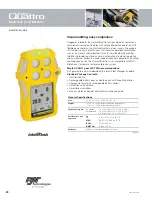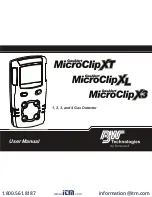
6
Body of the
removable
sensor
Power supply terminal
block+24V DC
Power supply
terminal block GND
Signal terminal block 4-20mA
Terminal resstor
RS485 A
Terminal resistor
RS485 B
NA
NA
NA
NA
Jumper connector of
the terminal resistor
RS485
Jumper connector of the
communication protocol
(DEGA/MODBUS)
Battery CR2032
DIP switch for the
RS485 adress
Programming
connector
LCD display connector
Status LED
Calibration jumpers
Instalation, assembly and disassembly of the transmitter
Before assembling, read the valid instalation standarts EN 60079-29-2 (Selection, instalation, use and maintenance of
detectors for combustible gases and oxygen) and EN 45544-4 (Guildelines for the selection, installation, use and maintenance
of detectors of toxic substances).
In explosive environments the electrical installation must be performed according to DIN EN 60079.14 (Electrical instalation in
hazardours areas)
Secure that the sensor is reachable by air. The transmitter must be in a free area with no obstacles in its way (furniture etc.)
Ensure that the input of the sensor cannot be polluted by layers of dust or other contamination.
1.
Assembly of the transmitter
The transmitter consists of four parts - the body of the transmitter, the removable sensor and Ex „d“ bushings.
Transmitter assembly procedure is as follows:
a)
Disassemble the transmitter with the four hexagon socket screws 4mm
b)
Disconnect the LCD motherboards
c)
Mount the transmitter on a flat surface with four 6mm fasteners in height above the floor with the gas entrance
facing downwards, as specified by the detected substance
d)
Direct the cable trough the bushing
e)
Connect the cabeling to the terminal block. When using the second Ex „d“ bushing, dismout the Ex „d“ blind plug.
It is allowed to use only Ex „d“ bushings with M20x1,5 threads
f)
Connect the LCD
g)
Assemble the transmitter with the four hexagon sockets scews 4mm
2.
Replacement of the sensor module
This activity must not be performed when the sensor is energized.
In case of need to replace the sensor module with a new piece, unscrew and remove the
cover. Disconnect the sensor module cable from the PCB (1), loosen the sink screw (2) and
unscrew the steel cylinder with the sensor (3). Screw the new sensor module, retain it
with the sink screw and connect the cable to the PCB. Finally, mount the cover and
connect to the power supply.
3.
Replacement of the battery
The battery lifetime in the sensor is approximately 5 years. After this time some functions of the
detector may not work properly. Remove the battery from the holder and replace it with one of the
recommended types. Replacing the battery in the transmitter, which is not connected to the power,
will erase the internal clock.
Panasonic BR2032
.
4.
Connecting the transmitter via current loop to the controler DEGA UPA II DEGA UPA III a DEGA UDA III
Connect one transmitter to each channel of the controler as shown in the picture below
14
13
16
15
12
11
10
9
22
21
20
19
18
17
6
5
8
7







































